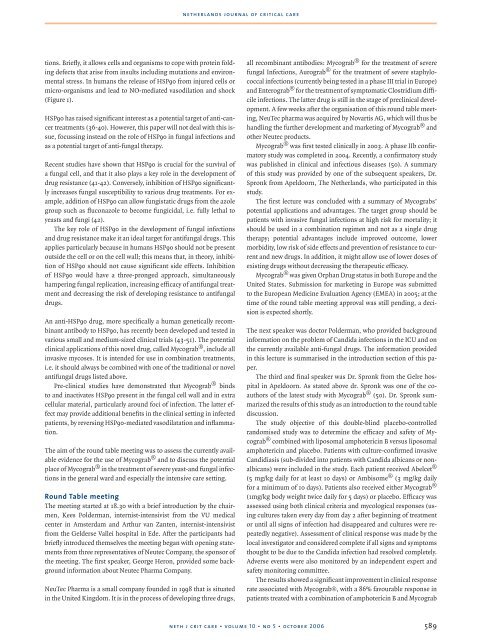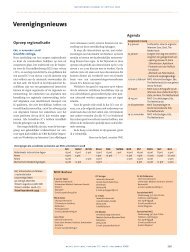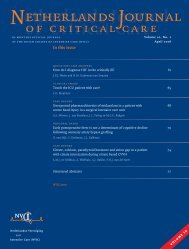Netherlands Journal
NJCC Volume 10, Oktober 2006
NJCC Volume 10, Oktober 2006
- No tags were found...
Create successful ePaper yourself
Turn your PDF publications into a flip-book with our unique Google optimized e-Paper software.
netherlands journal of critical care<br />
tions. Briefly, it allows cells and organisms to cope with protein folding<br />
defects that arise from insults including mutations and environmental<br />
stress. In humans the release of HSP90 from injured cells or<br />
micro-organisms and lead to NO-mediated vasodilation and shock<br />
(Figure 1).<br />
HSP90 has raised significant interest as a potential target of anti-cancer<br />
treatments (36-40). However, this paper will not deal with this issue,<br />
focussing instead on the role of HSP90 in fungal infections and<br />
as a potential target of anti-fungal therapy.<br />
Recent studies have shown that HSP90 is crucial for the survival of<br />
a fungal cell, and that it also plays a key role in the development of<br />
drug resistance (41-42). Conversely, inhibition of HSP90 significantly<br />
increases fungal susceptibility to various drug treatments. For example,<br />
addition of HSP90 can allow fungistatic drugs from the azole<br />
group such as fluconazole to become fungicidal, i.e. fully lethal to<br />
yeasts and fungi (42).<br />
The key role of HSP90 in the development of fungal infections<br />
and drug resistance make it an ideal target for antifungal drugs. This<br />
applies particularly because in humans HSP90 should not be present<br />
outside the cell or on the cell wall; this means that, in theory, inhibition<br />
of HSP90 should not cause significant side effects. Inhibition<br />
of HSP90 would have a three-pronged approach, simultaneously<br />
hampering fungal replication, increasing efficacy of antifungal treatment<br />
and decreasing the risk of developing resistance to antifungal<br />
drugs.<br />
An anti-HSP90 drug, more specifically a human genetically recombinant<br />
antibody to HSP90, has recently been developed and tested in<br />
various small and medium-sized clinical trials (43-51). The potential<br />
clinical applications of this novel drug, called Mycograb ® , include all<br />
invasive mycoses. It is intended for use in combination treatments,<br />
i.e. it should always be combined with one of the traditional or novel<br />
antifungal drugs listed above.<br />
Pre-clinical studies have demonstrated that Mycograb ® binds<br />
to and inactivates HSP90 present in the fungal cell wall and in extra<br />
cellular material, particularly around foci of infection. The latter effect<br />
may provide additional benefits in the clinical setting in infected<br />
patients, by reversing HSP90-mediated vasodilatation and inflammation.<br />
The aim of the round table meeting was to assess the currently available<br />
evidence for the use of Mycograb ® and to discuss the potential<br />
place of Mycograb ® in the treatment of severe yeast-and fungal infections<br />
in the general ward and especially the intensive care setting.<br />
Round Table meeting<br />
The meeting started at 18.30 with a brief introduction by the chairmen,<br />
Kees Polderman, internist-intensivist from the VU medical<br />
center in Amsterdam and Arthur van Zanten, internist-intensivist<br />
from the Gelderse Vallei hospital in Ede. After the participants had<br />
briefly introduced themselves the meeting began with opening statements<br />
from three representatives of Neutec Company, the sponsor of<br />
the meeting. The first speaker, George Heron, provided some background<br />
information about Neutec Pharma Company.<br />
NeuTec Pharma is a small company founded in 1998 that is situated<br />
in the United Kingdom. It is in the process of developing three drugs,<br />
all recombinant antibodies: Mycograb ® for the treatment of severe<br />
fungal Infections, Aurograb ® for the treatment of severe staphylococcal<br />
infections (currently being tested in a phase III trial in Europe)<br />
and Enterograb ® for the treatment of symptomatic Clostridium difficile<br />
infections. The latter drug is still in the stage of preclinical development.<br />
A few weeks after the organisation of this round table meeting,<br />
NeuTec pharma was acquired by Novartis AG, which will thus be<br />
handling the further development and marketing of Mycograb ® and<br />
other Neutec products.<br />
Mycograb ® was first tested clinically in 2003. A phase IIb confirmatory<br />
study was completed in 2004. Recently, a confirmatory study<br />
was published in clinical and infectious diseases (50). A summary<br />
of this study was provided by one of the subsequent speakers, Dr.<br />
Spronk from Apeldoorn, The <strong>Netherlands</strong>, who participated in this<br />
study.<br />
The first lecture was concluded with a summary of Mycograbs’<br />
potential applications and advantages. The target group should be<br />
patients with invasive fungal infections at high risk for mortality; it<br />
should be used in a combination regimen and not as a single drug<br />
therapy; potential advantages include improved outcome, lower<br />
morbidity, low risk of side effects and prevention of resistance to current<br />
and new drugs. In addition, it might allow use of lower doses of<br />
existing drugs without decreasing the therapeutic efficacy.<br />
Mycograb ® was given Orphan Drug status in both Europe and the<br />
United States. Submission for marketing in Europe was submitted<br />
to the European Medicine Evaluation Agency (EMEA) in 2005; at the<br />
time of the round table meeting approval was still pending, a decision<br />
is expected shortly.<br />
The next speaker was doctor Polderman, who provided background<br />
information on the problem of Candida infections in the ICU and on<br />
the currently available anti-fungal drugs. The information provided<br />
in this lecture is summarised in the introduction section of this paper.<br />
The third and final speaker was Dr. Spronk from the Gelre hospital<br />
in Apeldoorn. As stated above dr. Spronk was one of the coauthors<br />
of the latest study with Mycograb ® (50). Dr. Spronk summarized<br />
the results of this study as an introduction to the round table<br />
discussion.<br />
The study objective of this double-blind placebo-controlled<br />
randomised study was to determine the efficacy and safety of Mycograb<br />
® combined with liposomal amphotericin B versus liposomal<br />
amphotericin and placebo. Patients with culture-confirmed invasive<br />
Candidiasis (sub-divided into patients with Candida albicans or nonalbicans)<br />
were included in the study. Each patient received Abelcet ®<br />
(5 mg/kg daily for at least 10 days) or Ambisome ® (3 mg/kg daily<br />
for a minimum of 10 days). Patients also received either Mycograb ®<br />
(1mg/kg body weight twice daily for 5 days) or placebo. Efficacy was<br />
assessed using both clinical criteria and mycological responses (using<br />
cultures taken every day from day 2 after beginning of treatment<br />
or until all signs of infection had disappeared and cultures were repeatedly<br />
negative). Assessment of clinical response was made by the<br />
local investigator and considered complete if all signs and symptoms<br />
thought to be due to the Candida infection had resolved completely.<br />
Adverse events were also monitored by an independent expert and<br />
safety monitoring committee.<br />
The results showed a significant improvement in clinical response<br />
rate associated with Mycograb®, with a 86% favourable response in<br />
patients treated with a combination of amphotericin B and Mycograb<br />
neth j crit care • volume 10 • no 5 • october 2006<br />
589







